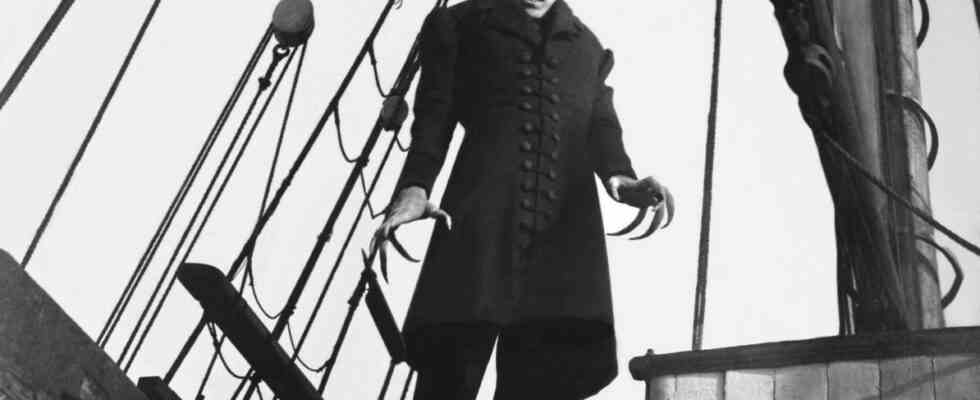The name stands for absolute horror, for boundless horror, for a hundred years: “Nosferatu… Doesn’t that word sound to you like the midnight call of a dead bird. Be careful not to say it…” That’s what it says at the beginning of the film “Nosferatu”, by Friedrich Wilhelm Murnau, one of the greatest filmmakers in history. Nosferatu is the original vampire of the silent film era – a hundred years ago, in the spring of 1922, the film premiered in Berlin. A few days ago, the exhibition “Phantoms of the Night. 100 Years of Nosferatu” was opened in his honor in the Scharf-Gerstenberg Collection (until spring 2023), which is dedicated to the relationship between this film and the fine arts.
Everyone knows Nosferatu, everyone has in mind the horror figure with the pointed ears, fingernails and teeth, who bloodthirsty goes after her victims’ necks, finally sets off with a row of coffins in a sailing ship and brings the plague to Europe – there are rats in the coffins. In his loneliness and his desire for love, the vampire looks miserable.
Of course, the vampire also has a thoroughly bourgeois side, something terribly stuffy when he first receives his guest in his castle in the Carpathians, Hutter, the envoy of the real estate agent Knock from the German port city of Wisborg. His name is Count Orlok, a scrawny little man in a house coat and cap, withered and fuzzy, who, as Rosa von Praunheim mocked, “trips to meet the young guest like a horror queen”. During the conversation, Hutter drops a medallion on the table with a picture of his wife Ellen in it. “Your wife has a beautiful neck,” remarks the Count lasciviously and deliciously.
The producer of the film was an important figure in the esoteric scene in the 1920s
A most overlooked aspect of the character emerges in the mysterious letter the Count sends to the real estate agent, a letter filled with esoteric and occult characters and symbols. The sketch of a house can be seen in the middle, so that one knows that the Count is planning to buy a property. Knock reads this letter in the first few minutes of the film, line by line, nodding maliciously and laughing sardonically – the letter is only seen in two shots, for seconds, impossible to decipher in the short space of time. The screenplay only mentions “illegible scribbles”, in the film you can certainly think about what secret knowledge these lines might contain.
Key scene: the mysterious letter in the film “Nosferatu”.
(Photo: Screenshots/youtube)
The letter, as it appears in the film, was particularly important to the second man behind “Nosferatu” – Albin Grau, born in 1884. He created the set designs and costumes, as well as the film’s storyboard and many of the fantastic commercial motifs. With his partner Enrico Dieckmann he founded Prana-Film, which produced the film. “Nosferatu” was heavily inspired by Bram Stoker’s novel “Dracula”, but the two producers had not taken care of the rights to it. The widow Stoker sued, and in 1924 a court ordered the destruction of all prints and negatives of the film. The Prana went bankrupt, but “Nosferatu” had already sailed away in dozens of copies, into cinema history.
For Albin Grau, Orlok was a figure of the occult and spiritual. In the 1920s he was an important figure in the esoteric scene in Berlin, a member of the Pansophical Society and the Fraternitas Saturni. In 1924, Grau attended the ominous Weida Conference and took on Aleister Crowley, a key figure in the occult scene in the first half of the century. When Fraternitas was banned by the Nazis in 1936, Grau went to Switzerland. After the war he returned to Germany, to Bayrischzell, where he lived until his death in 1971. A detailed study by Stefan Strauß on Albin Grau, for which he researched for years, will be published next spring by Belleville-Verlag.
Director Murnau’s pictures still trigger majestic shudders today
For Albin Grau, Orlok’s letter is the film’s secret force field; it is mysteriously present in its “illegibility”. “The vampire is an aristocrat of great erudition,” writes Sylvain Exertier in an essay in the film magazine as early as 1980 positiveNo. 228: “The knowledge that he possesses according to magical tradition was imparted to him in secret, which gives this vampirism an elitist character, in contrast to popular witchcraft.”
In his reading, Exertier refers to occult scholars, identifies symbols, astrological signs or tarot elements, draws narrative conclusions – for all its erudition, the text has a playful style that repeatedly borders on the pathetic and parodic: “Nosferatu sets out on the crusade and like the ‘Crusaders of St. John of Jerusalem’, his contemporaries, he uses the Maltese cross, but blackened, filled in with the ink of the conspirator, the bringer of death. Two Maltese crosses frame this first line, giving it the appearance of a heading.”
When the crusader’s death ship carrying the coffin of Nosferatu enters the port of Wisborg, Murnau’s pictures still trigger a majestic shudder today. Knock, who ran the count’s business, has since been locked away in an asylum. He senses the arrival of Nosferatus: “The master is near, the master is near.” Dracula is also revered as a master in Bram Stoker’s novel, but Orlok takes on a mysterious, almost transcendent aura against the backdrop of Albin Grau’s worldview. He is, especially in the first part of the film, a dazzling, sinister outsider, an esoteric, a high priest, a lateral thinker.

